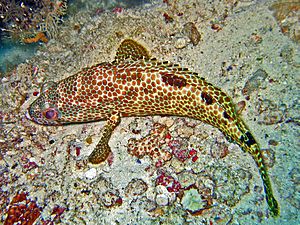Foursaddle grouper facts for kids
Quick facts for kids Foursaddle grouper |
|
|---|---|
 |
|
| Epinephelus spilotoceps in Maldives | |
| Conservation status | |
| Scientific classification | |
| Synonyms | |
|
Epinephelus salonotus J.L.B. Smith & M.M. Smith, 1963 |
The Epinephelus spilotoceps, also known as the foursaddle grouper or spotty cod, is a type of grouper fish. It belongs to a group of fish called ray-finned fish. This fish lives in the warm waters of the Indo-Pacific region.
Contents
What Does the Foursaddle Grouper Look Like?
The foursaddle grouper is a medium-sized fish. It can grow up to about 35 centimeters (14 inches) long. Its body is about 3 to 3.5 times longer than it is deep.
Body and Head Features
This fish has a flat area between its eyes. The top of its head curves gently upwards. The bone near its gills is rounded and has a small dip. The edges of this bone are a bit spiky. Its gill cover has a straight top edge.
Fins and Color
The foursaddle grouper has several fins. Its dorsal fin (on its back) has 11 strong spines and 14 to 16 soft rays. The anal fin (on its belly) has 3 spines and 8 soft rays. Its caudal fin (tail fin) is rounded.
The body and head of this fish are usually pale in color. They are covered with many dark olive-brown or reddish-brown spots. These spots are close together, forming a net-like pattern. You can also see four dark, saddle-shaped blotches on its back. Three of these are along the base of the dorsal fin, and one is on its tail section. The outer parts of its pectoral fins (side fins) are yellowish-green.
Where Does the Foursaddle Grouper Live?
The foursaddle grouper is found across a wide area called the Indo-West-Pacific. This includes the eastern coast of Africa, from Kenya down to Mozambique. It also lives around many islands in the Indian Ocean, like Mauritius, Maldives, and the Chagos Archipelago.
Eastward Journey
From there, its home stretches eastward through the Malay Archipelago to places like Micronesia, the Line Islands, and the Cook Islands. You can also find it south near the Great Barrier Reef and off the northwestern coast of Australia. However, it is not found in the South China Sea or the Java Sea. This fish prefers living around islands, except for its coastal areas off East Africa.
Habitat and What It Eats
The foursaddle grouper lives in shallow coral reefs. It often hangs out in small reefs found within lagoons. It also likes the upper parts of channels that cut through reefs and the outer edges of reefs.
Finding Food and Shelter
In the Maldives, these fish have been seen in areas with lots of rubble. They usually stay close to more complex coral formations, avoiding open spaces. When kept in aquariums, they are known to eat small crustaceans (like crabs and shrimp) and other fish.
How We Study the Foursaddle Grouper
The foursaddle grouper was first officially described in 1953. An American scientist named Leonard Peter Schultz gave it its scientific name. He found the first known specimen near Namu Island in the Marshall Islands.
Related Groupers
This species is part of a group of related groupers called "reticulated coral groupers." Other fish in this group include Epinephelus hexagonatus and Epinephelus merra. These fish look quite similar, so they have often been mistaken for each other in museums.
How People Use the Foursaddle Grouper
The foursaddle grouper is a small fish. It's not a big part of commercial fishing, but local fishers do catch it for food in many areas.
Fishing and Aquariums
In Pohnpei, people catch them using spears. In the Maldives, some are caught and sold for the live reef fish food trade. You might also see this fish in the aquarium trade, where people keep them as pets in large tanks.
See also
 In Spanish: Epinephelus spilotoceps para niños
In Spanish: Epinephelus spilotoceps para niños


